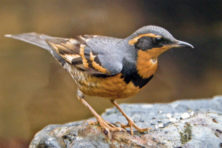Door to Nature: Bird Conservation Events in May
- Share
- Tweet
- Pin
- Share

Global Big Day – the annual, worldwide birding event – will be held May 8, and anyone with internet access can participate. It is a way to conduct a one-day census of bird species and numbers throughout the world’s birding community.
Cornell University in Ithaca, New York, developed the online eBird organization through its Cornell Lab for Ornithology. It will tabulate this year’s results and make them available, and you can also see the 2020 Big Day totals through online articles.
Go to ebird.org/globalbigday to find out how to enroll and participate in the 2021 Global Big Day and to learn more about birds that you see during this active time of spring migration. You can also download an app to help you identify birds as you observe them in the field.
It might be helpful to seek out an experienced birder in your community to help you get started. It is a wonderful way to enjoy the outdoors on warm, sunny spring days and take in the many blooming wildflowers, too. Contact your nearest nature center to find a birding companion or the birding help you may need.
I remember the birdathon that my late husband, Roy, and I developed as a fundraiser for The Ridges Sanctuary in the late 1980s. We chose one day in May to find as many species of birds as we could and traveled throughout the county. People donated various amounts, from 10 cents to a dollar per species.
Spring is the time to get out and listen to the territorial songs of nesting birds. Other birds also may sing as they travel through on their way north to their breeding areas. The Merlin Bird ID app can help you identify the species you see.
Another way to help the bird population in our state is to contribute to the Great Wisconsin Birdathon (wisconservation.org/birdathon), which is run by numerous teams that do a 24-hour census of diverse habitats to find as many species as possible. If you contribute to a team, you can get a report of where they traveled and what they found.
The statewide sponsor is the Natural Resources Foundation of Wisconsin, and the money raised goes to its Bird Protection Fund. Other sponsors include the Wisconsin Society for Ornithology and the Wisconsin Bird Conservation Partnership.
At the Great Wisconsin Birdathon’s participation site (go.dojiggy.io/wibirdathon/Campaign), you can see the participating teams and their fundraising goals. People have given their teams some very clever names. This year I am supporting the Vaccinated Vireos.
When we did The Ridges Sanctuary’s birdathon, we scheduled it for a day in the third week of May because it was felt that the peak of warbler migration would happen during that part of the month. A day or two of strong south winds help the migrating birds move northward.
The push of migrating birds happens during the nighttime hours, which allows them to rest and feed during the day. Sometimes certain species “overshoot” their range and show up in Door County when they’re not expected here.
Some of the more unusual species that have turned up in Door County in May include the scissor-tailed flycatcher, painted bunting, summer tanager and yellow-throated warbler. Roy had a regular nature column in the Door County Advocate for more than 35 years and then in the Peninsula Pulse, so people would call to tell him about these strange birds. Roy was able to document and photograph several of them over the years.
Other rare species showed up on Washington Island, such as the yellow-headed blackbird, tropical kingbird, black vulture and crested caracara. A Townsend’s solitaire has appeared a few times in the county as well.
This is why it is important for more people to become aware of the birds in our county. When some new or very different species show up, then we birders can be alerted. My friend Deb Ford has revised our Door County Birders Network email alert. It is free to join, and when you do, you can learn which birds are being seen and contribute your own sightings.
All of this awareness is beneficial to learning more about birds, appreciating them in our environments and helping to protect them and their habitats. We all share this Earth and need to care for it so that every being can survive and thrive.




